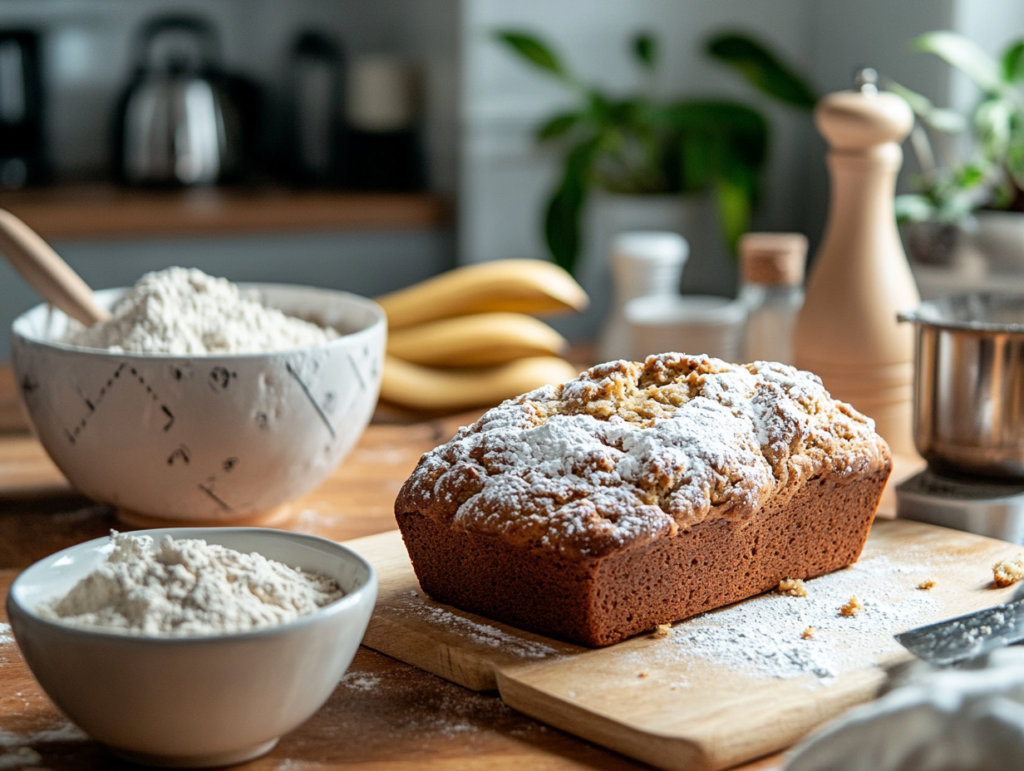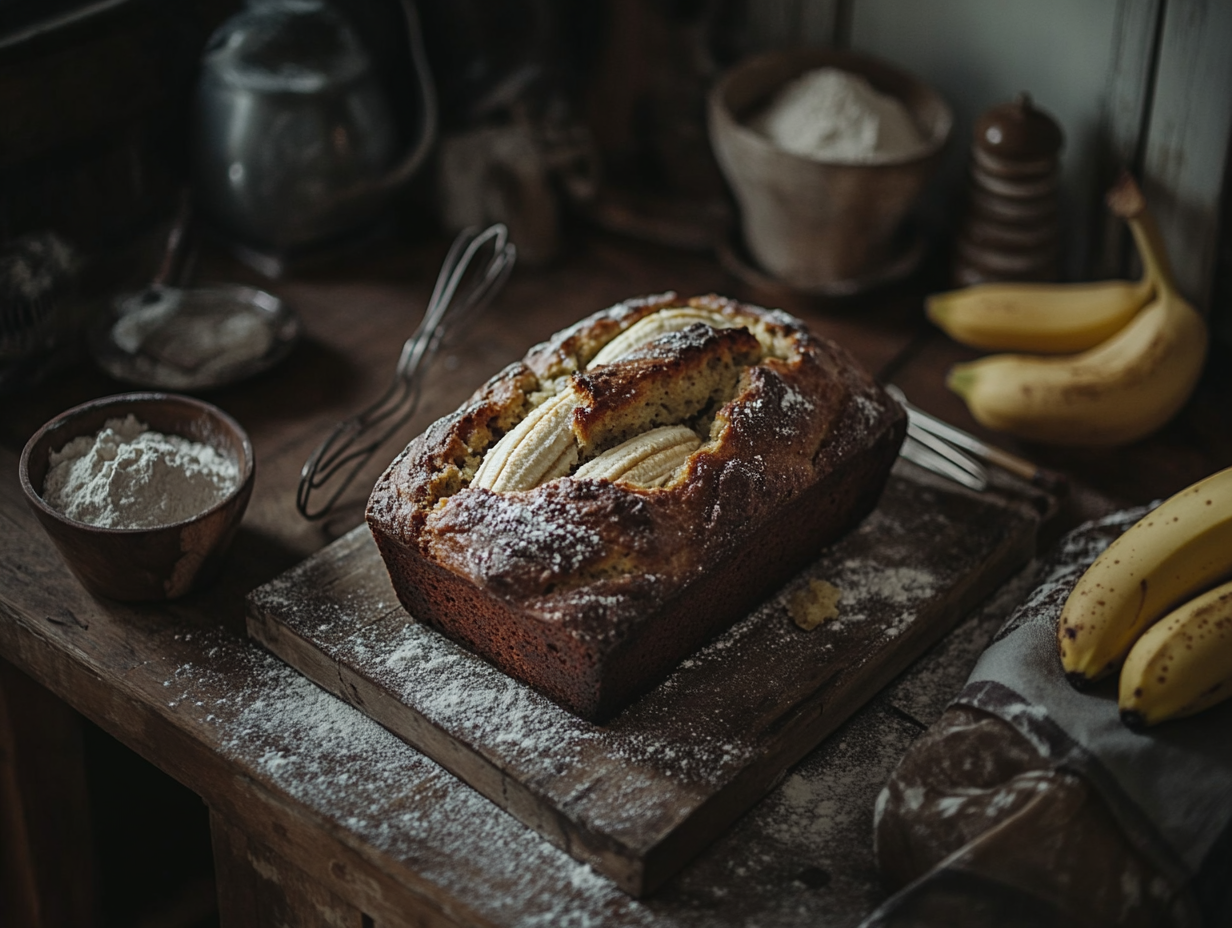Banana bread is the kind of comfort food that brings warmth to the heart, but what happens when your loaf emerges from the oven looking more like a pancake? 😢 If you’ve ever wondered, “Why does my banana bread not rise?”—you’re not alone. This common baking hiccup can be frustrating, especially when you were hoping for that fluffy, golden perfection.
In this article, we’ll dive into the reasons your banana bread might not rise, explore solutions to fix those problems, and even sprinkle in some pro tips to ensure your next bake is a soaring success.
Understanding the Science of Banana Bread Rising
Before we dive into the nitty-gritty, let’s get a handle on the science behind why banana bread rises in the first place. Think of baking as a delicious chemistry experiment. When all the ingredients are combined correctly, they create magic in the oven.
The Role of Leavening Agents in Baking
Leavening agents like baking soda and baking powder are the unsung heroes of banana bread. These little powerhouses release carbon dioxide gas when they react with heat or acidic ingredients (like bananas). This gas creates bubbles, and those bubbles are what give your banana bread its lift.
Ever skipped adding baking soda? That’s like trying to blow up a balloon with no air. The rise just won’t happen.
“Leavening agents are like the jet fuel for your batter—they give it the power to soar!” 🚀
Importance of Proper Mixing Techniques
Mixing might seem straightforward, but it’s surprisingly easy to mess up. Too much mixing can deflate the batter, while too little mixing might leave ingredients unevenly distributed. Both scenarios can sabotage the rise.
Think of it like folding laundry—gentle yet thorough is the way to go.
How Moisture Content Affects Rising
Banana bread needs the right balance of moisture. Too much liquid can weigh down the batter, while too little can make it dry and dense. Bananas naturally add moisture, but the ratio of wet to dry ingredients must be just right.
Common Reasons Why Banana Bread Fails to Rise

Banana bread not rising can often boil down to a handful of common culprits. Let’s break them down and tackle each one.
Expired Baking Powder or Baking Soda
Leavening agents don’t last forever. If your baking soda or baking powder is past its prime, it won’t create enough gas to lift the bread.
Here’s a quick test: Mix a teaspoon of baking powder with hot water. If it fizzes, you’re good to go! If not, it’s time for a replacement.
Incorrect Measurement of Ingredients
Baking is a game of precision. A pinch too much flour or too little baking soda can completely change the outcome. Always measure your ingredients carefully using the right tools—like a kitchen scale for dry goods.
Overmixing the Batter
Overmixing introduces too much air and breaks down the gluten structure. Instead of a fluffy loaf, you’ll end up with a dense brick. Stir until the ingredients are just combined—no more, no less.
“Think of your batter like a fragile ecosystem. Handle it with care, and it’ll thrive!”
Oven Temperature Issues
If your oven isn’t hot enough or the temperature fluctuates, the leavening agents might not activate properly. Invest in an oven thermometer to ensure your oven is calibrated correctly.
Solutions for Flat Banana Bread
Alright, now that we’ve identified the problems, let’s talk about fixing them. After all, we’re here for fluffy banana bread that’s tall, proud, and oh-so-delicious. 😋
Ensuring Fresh and Active Leavening Agents
Always check the freshness of your baking powder and baking soda. Store them in a cool, dry place, and replace them every six months. This one small step can make a massive difference.
Mastering Accurate Ingredient Measurements
Use measuring cups for liquids and a scale for dry ingredients. Don’t eyeball it—precision is key to success.
Pro tip: When measuring flour, use the “spoon and level” method to avoid packing it down.
Avoiding Overmixing: A Step-by-Step Guide
When combining wet and dry ingredients, use a spatula or wooden spoon and fold gently. Stop mixing as soon as you can’t see any dry flour. Overmixing is like overthinking—it usually does more harm than good.
Calibrating Your Oven for Perfect Results
An oven thermometer is your best friend. Preheat your oven for at least 15 minutes and check the temperature before baking. Most recipes call for 350°F (175°C)—stick to it unless specified otherwise.
“Your oven is the stage; make sure it’s set perfectly for your star performance!”
Troubleshooting Specific Problems with Banana Bread
Let’s address some of the most common issues that arise with banana bread and how to tackle them head-on.
What to Do If Banana Bread Is Dense?
Dense banana bread is usually a sign of too much flour or not enough leavening. Double-check your measurements, and consider sifting your dry ingredients to make them lighter.
Why Does My Banana Bread Collapse After Baking?
This happens when the bread rises too quickly and then falls. To avoid this, make sure your oven isn’t too hot, and don’t open the oven door while it’s baking. Patience is key!
How to Prevent Cracks on the Top of Banana Bread?
Cracks can occur when the batter is too thick or the oven is too hot. To prevent them, smooth the batter’s surface with a spatula before baking and ensure the oven temperature is spot-on.
Pro Tips for Perfectly Risen Banana Bread

Achieving that perfectly risen banana bread doesn’t require magic—it’s all about technique, a little patience, and some insider secrets. Let’s level up your banana bread game with these expert tips.
Choosing the Right Type of Flour
The type of flour you use can make or break your banana bread. All-purpose flour is the most commonly used and gives a reliable texture. However, if you’re using whole wheat or alternative flours like almond flour, remember that these absorb moisture differently. Adjust your wet ingredients accordingly.
Pro tip: Sifting your flour before adding it to the mix helps prevent clumps and aerates the batter for better rising.
Balancing Wet and Dry Ingredients
The perfect batter isn’t too thick or too runny—it’s somewhere in between. If your batter is overly wet, the bread won’t rise properly, and if it’s too dry, it can turn out dense.
“Think of your batter as Goldilocks—it needs to be just right.”
One way to test the balance is by running a spoon through the batter. It should be thick enough to coat the spoon but still flow slowly when poured.
Using Ripe Bananas for Enhanced Texture
Ripe bananas are the MVP of banana bread. They not only add natural sweetness but also contribute moisture, making the bread soft and fluffy. The riper (we’re talking brown and spotty), the better.
If you’re short on ripe bananas, you can ripen them quickly by baking them in their peels at 300°F for 15-20 minutes. Let them cool before mashing.
Incorporating Air While Mixing
Air is your secret weapon for a lighter loaf. When you cream butter and sugar together or whisk eggs, you’re introducing air into the batter. Be gentle when folding in the dry ingredients to avoid losing all that air.
Frequently Asked Questions About Banana Bread
Let’s tackle some burning questions you might have about banana bread. After all, curiosity is the key to better baking. 🧁
Can I Substitute Baking Powder for Baking Soda?
Yes, but it’s not a 1:1 substitution. Baking powder contains both an acid and a base, so you’ll need about three times the amount of baking powder to replace baking soda. However, this can slightly alter the taste and texture of your bread.
How Can I Make My Banana Bread Gluten-Free?
Making gluten-free banana bread is entirely possible with the right flour blend. Look for gluten-free all-purpose flour that includes xanthan gum, which helps mimic the elasticity of gluten. Be cautious, as gluten-free batters tend to be wetter—don’t overmix.
What Happens if I Forget to Add Leavening Agents?
If you forget to add baking soda or baking powder, your banana bread won’t rise, resulting in a dense loaf. While it’ll still taste good, the texture will be more like a banana pudding. Pro tip: Always double-check your recipe before mixing!
Conclusion: Achieving Banana Bread Success Every Time
At the end of the day, banana bread is as much an art as it is a science. From ensuring fresh ingredients to mastering the balance of wet and dry, every step plays a role in that beautiful, fluffy rise. Even if you’ve faced a few flat loaves in the past, don’t give up. Baking is a journey, and every loaf teaches you something new.
Remember, the next time you’re wondering, “Why does my banana bread not rise?”—you’ve got all the answers at your fingertips. Happy baking! 🍌
Related Recipes and Inspiration
Link to Perfect Banana Bread: Tips, Recipes & Solutions as a comprehensive guide for troubleshooting and perfecting banana bread recipes.
Link to Easy Kefir Sheet Cake for readers interested in exploring other baking ideas.

